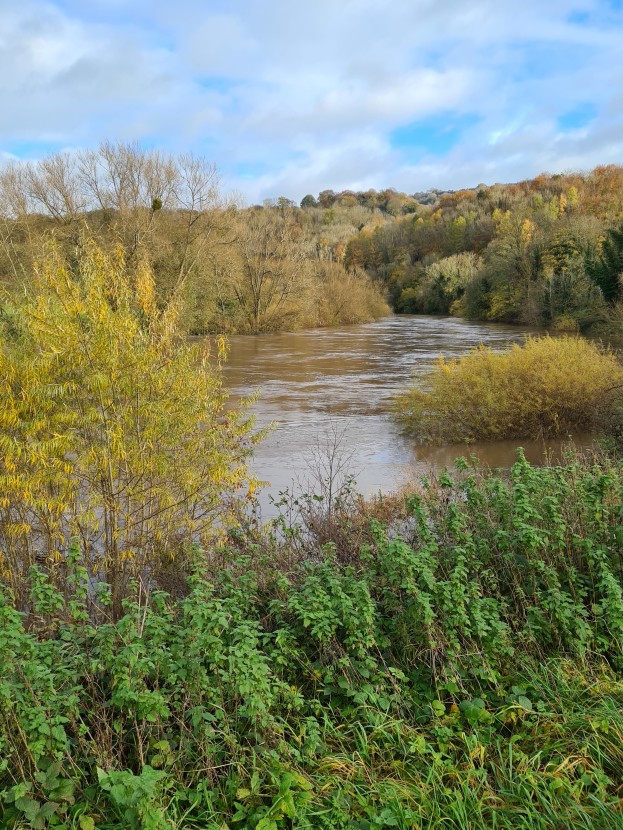 Middle Wye in flood
Middle Wye in flood I’m rather disappointed this year. Every grayling angler dreams of those perfect autumn days we think we can expect in October – mild, sunlit, perfect for the hatching fly, for wading carefully and for fishing dry on the surface. Such days did not arrive this season, or very few of them did. Instead, after that summer of drought, the rain kept coming. Our coarse anglers struggled on into November, fishing a flooding Wye with heavy gear for barbel and chub, and relying on the strong scent of the bait as an attractor. Flood fishing can be effective, but the conditions including slippery banks made it challenging. Dog spikes and ropes were useful safety aids at times. Some people blanked; others managed a modest catch and a few more really did quite well. On 2nd November RL from Chelmsford with a companion took a haul of 40 barbel and 12 chub from The Creel. SJ from Farnborough with a friend had 4 barbel, 2 of them over 9 pounds, plus 3 chub at Middle Hill Court. However, about fishing 5th November on the Creel with two friends, RR from Bridgend wrote:
“A lovely stretch of water but easily up by two metres and extremely difficult to get anything nailed down. Racing through and rather like drinking chocolate. No real slack areas. Attempts made but a fair bit of gear lost. Will definitely return next year, when things are a little less turbulent.”
MK from Boston with a friend found conditions a little easier at How Caple Court:
“What a great day on the Wye. Caught 9 barbel, the biggest was 9 pounds 10 ounces, and the second biggest was 9 pounds 7 ounces. Lost 9 barbel to under water bankside vegetation. Wye came up by 30cm in the day’s session. Caught on pellet and curried luncheon meat.”
KS from Chippenham had a barbel of 8 pounds and 3 chub at the Creel, but unfortunately dropped his phone in the river. (Which possibility is one of several reasons, please note, that I rarely take my phone with me when fishing. However, my wife now insists that I must take one if I plan to go sea trout fishing at night. I guess I am old and doddery enough for people to worry). IS from Gloucester fished at How Caple Court for 6 barbel to 9 pounds and 7 chub to 5 pounds using Vortex pellets. He noted that the fish were “on the flow side of the crease,” but not in slack water. On the 11th PT from Kidderminster had 9 grayling presumably trotting the Lugg at Eyton, although the water was high. Up on the Tees at High Coniscliffe, JD from Newcastle managed 4 grayling on the 12th. C from Devon fished at Middle Hill Court on the 14th and reported:
“River level up 1.2 metres overnight and really pushing through so was not accepting much success. 5 chub all over 4 pounds, and 5 barbel including fish of 8.5 and 9.5 pounds. All fish caught in bottom field, rod length out, in the crease on meat/pellet.”
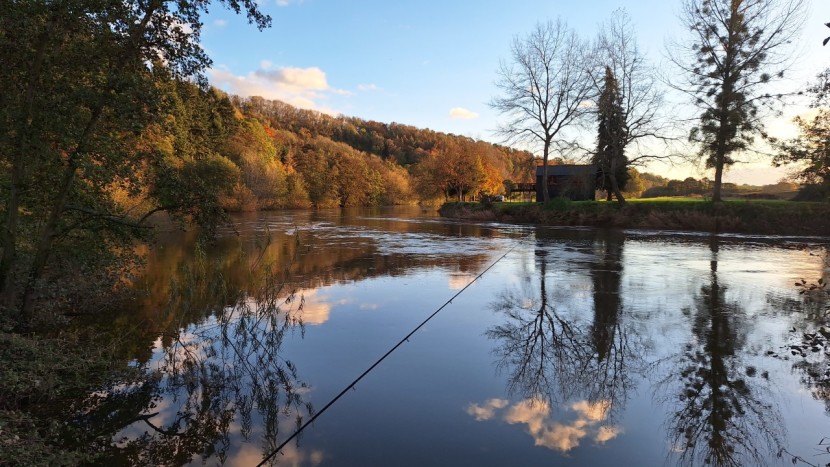 Fishing a slack - KT from Bath
Fishing a slack - KT from Bath 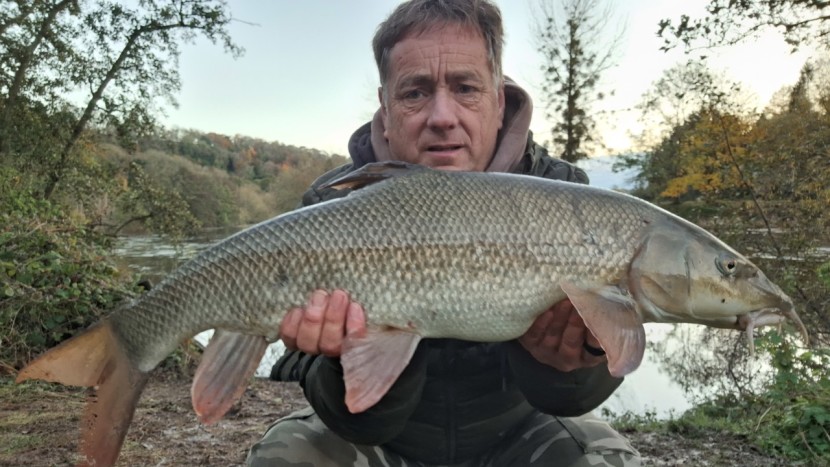 How Caple Court - KT from Bath
How Caple Court - KT from Bath MB from Swansea had a barbel of 6 pounds and 4 chub while fishing at How Caple Court on 17th November. SH from Weston Super Mare with a friend had a barbel and 6 chub from Strangford. SL from Hockley Heath, a client of mine and very keen, drove up to Llangollen Maelor where he managed 2 grayling, one of them on a dry fly. The River Dee was very high, but “…always worth trying a dry on some of the seams.” On the 21st MS from Isleworth manged 12 chub at Middle Hill Court. With 2ft 6 inches still on the Llanstephan gauge, for want of any other ideas I tried fishing the Irfon Junction Pool at Builth Wells with the trotting gear. There was no question of wading, but this is a wide pool of deep eddies where you can work a float through while perched safely on the bank. The current was fast but at least the water was clear; a couple of times a dark coloured salmon showed with a slap at the surface, which made an encouraging sight despite our worries about the run. Results over about 6 hours were 10 very modest sized grayling plus a couple of out of season trout, one of which coughed up a salmon parr in the net. AW from Treharris took 2 barbel and 11 chub to 5.9 pounds at Lower Canon Bridge. We turned something of a corner that final week with the air temperature plunging and the rain finally ceasing, leaving the level of the Wye now hovering, a strong current running cold and clear. At last some grayling in nice condition began to appear in the returns. AP from Wirral took 8 grayling trotting at Abernant, while GP from Cardiff had 12 at Llangoed and Lower Llanstephan.
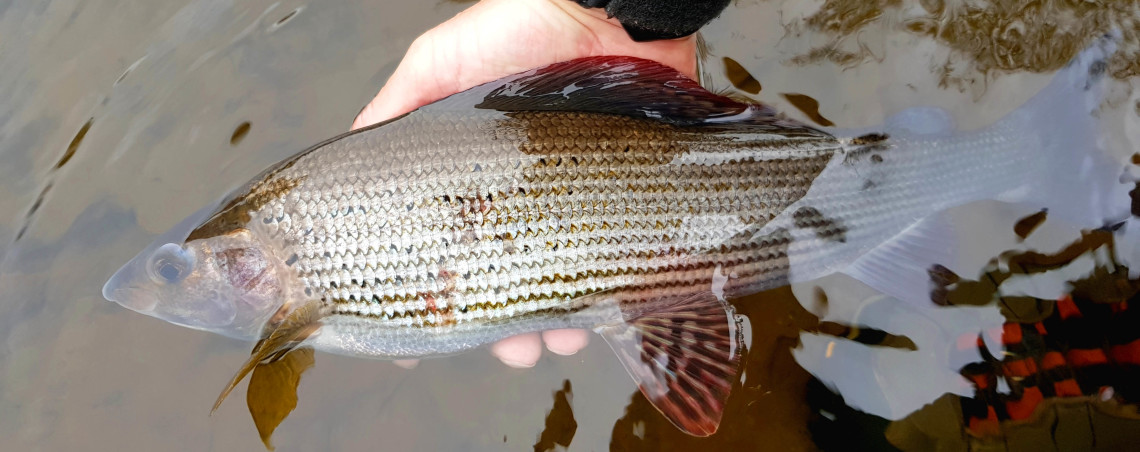 Irfon grayling from Melyn Cildu
Irfon grayling from Melyn Cildu As already described, while the coarse fishers pressed on with the barbel and chub there were only a few opportunities for game fishers with the grayling due to the high water levels through most of October and November. Just to cheer you up, here is a video made late in October by friend and fellow guide Lyn Davies. Confronted by flood levels almost everywhere else, he decided to try the top of the Irfon at the Colonel’s Water. Although I believe the Cilmery gauge was showing 0.80 at the time, which would have been high enough to prevent fishing lower down, as it turned out the water was clear and he had a decent day as you will see. Note the number of out of season trout in the Irfon this year compared to grayling. Here is the link:
Many of us have been ruminating about the past season of 2023 and the general “state of the nation” on our rivers. There is no denying that 223 salmon was a very low rod catch for the Wye and it comes after another prolonged period of summer drought and poor catches. We are hearing now that 2023 will probably turn out to be the warmest year ever recorded worldwide. Once more we had fishing suspended in the interests of fish welfare. 2017 was the last really decent salmon year with 1,212 fish, and even that doesn’t compare with the glory days of the river. It is difficult to get good figures for the Usk, but the 2023 result was also probably worse than usual. 100 fish, mostly from the lower river, is the best estimate I can find at the moment. “No day and no weather is hopeless, if there are salmon in the pools…” wrote AH Chaytor famously in his Letters to a Salmon Fisher’s Sons of 1910. True enough, but I firmly believe that there were few salmon in our rivers this year. Occasionally a fish would show and some determined anglers kept at the game long enough to get a result, but while out and about on the river with other business this season past, I wasn’t often aware of salmon being around in any great number. Along with some roaming gentlemen of unfortunately nefarious intentions, this year’s winter grayling anglers, if levels will only drop a little, will probably get an idea of how many salmon are present in the spawning areas of the upper Wye and tributaries.
Of course anglers’ experiences are anecdotal and not to be relied upon in the scientific sense. Some anglers are better at the game than others and of course angling effort varies. Sometimes angling experiences actually contradict the science. For example, scientific sampling by electro-fishing tells us that the numbers of adult brown trout are down in the main Usk, but in fact some lovely Usk specimens were caught this spring. Anecdotally again, I’m prepared to make an angler’s generalisations about the rivers I have known over time. Numbers of brown trout in the main Monnow stem appear to be much reduced in recent years, although the upper tributaries are holding up better. Very few salmon seem to make it into the Monnow, despite attempts to modify Osbaston Weir.
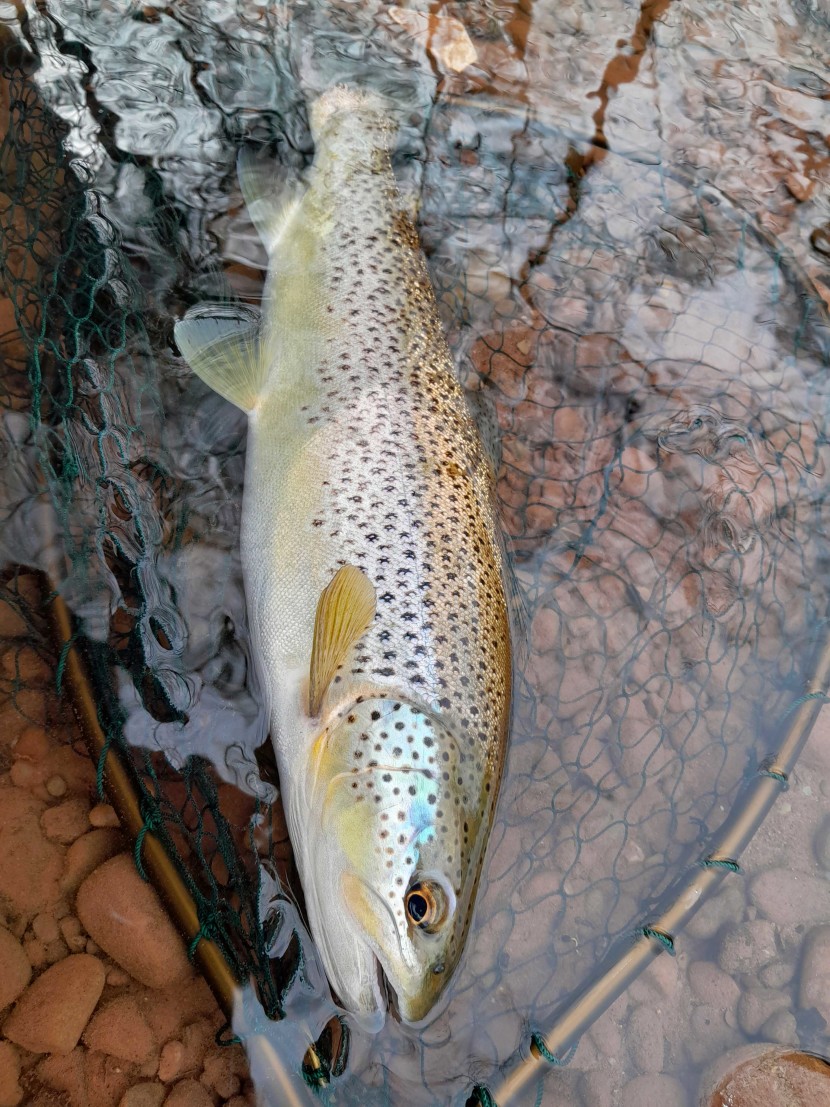 Usk trout from early this season
Usk trout from early this season  Winter grayling fishing on the Lugg
Winter grayling fishing on the Lugg One needs to careful when voicing an opinion about grayling numbers anywhere. Grayling, like salmon, are a fast growing but short lived species, and their numbers vary according to spawning success in recent years. We still have grayling in the main Wye, although seemingly not in the numbers we have been used to until quite recently. The fishing gets better as you go upstream. I have been very worried recently about grayling numbers in the Irfon, although there are still a few heavy fish at the top end. The Irfon these days is producing more trout, including big ones. The Ithon once had quite a reputation as a trout stream, but not in recent years and this doesn’t seem to have changed. There are some big grayling in holes at the top end. The Arrow also seems short on grayling at the moment, although it used to produce plenty, including large fish. The Lugg on the other hand still has a healthy head of grayling of all sizes. Trout fishing on the Wild Stream tributary brooks also suffered from the 2023 drought and many anglers complained about the level of growth which is obstructing fishing. I’m hardly a specialist on the chalk streams, but the word from Hampshire is that the mayfly season and dry fly fishing in general was disappointing this year. Fish just weren’t rising. Certainly my own experience on the Wiltshire Avon was that nymph fishing was often a more successful method during 2023. Meanwhile, as Welsh friends remind me, there are always the llyns, those high mountain lakes with ancient trout populations which have been fishing as well as always.
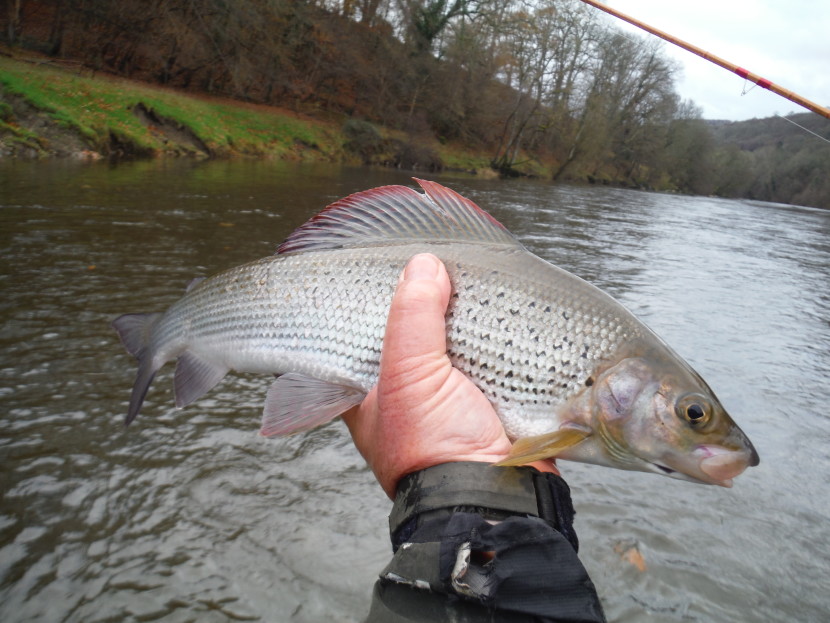 November grayling
November grayling  Wye above Builth
Wye above Builth With the rivers flooded and out of commission this month, I spent a few mornings fishing for rainbow trout in our Forest Pool. As usual during the autumn, when temperatures fell the fish became more aggressive with some fry feeding going on. I usually stay only for a couple of hours here, leaving early before the surrounding paths become busy with walkers. And when fishing early as I do, I tend to run into the predators on their visits to the pool. I quite expect to find the familiar kingfisher and heron when I arrive, nor do I worry much about them as I know that they concentrate on eating smaller fish. There are plenty of sticklebacks and roach in the pool to engage such fishing birds, just as our larger stocked trout like to chase the same coarse fish by the weed beds at this time of the year. I’m much less happy when occasionally I come across a cormorant fishing our water, and in some ways the goosanders which visit the pool during winter months are even worse. A goosander, I suppose, is not capable of eating a 2.5 pound rainbow trout and will be concentrating on the roach. Nevertheless, the flocks of goosanders working in close co-ordination harry all the fish up and down, particularly in the tighter corners of the lake. There were ten goosanders when I arrived at the pool today, cruising and diving in line. The rainbow shoals were as affected as they would have been if anglers had cast over them for hours. Goosanders were even diving under the sunken willow which the rainbows have adopted as a refuge. Still, goosanders are by nature shy and a loud clap drove them away. The shoal of rainbows were still penned in tight. When I located them and after they had eventually settled, I managed to catch fish one after the other using a floating line, long leader and a Gold Head Damsel nymph.
Our present syndicate is now more than 70 years old, but for many years there were conflicting stories about the origin of our Forest Pool, which is the lowest of a chain of four in a narrow valley just above the Dean Heritage Centre at Soudley. Who built the dams and why? For some reason it was never written down and oral tradition is often unreliable. It would be logical to assume that the pools were built to provide additional water for Camp Mill, which lies with a pond of its own just below the last dam which carries the road from Cinderford to Blakeney. I can remember the empty shell of Camp Mill during the 1960s when it was occupied by a car breaker’s yard, the most unsightly mess you could imagine. Today it houses the Dean Heritage Centre and a café. It now seems that Camp Mill when working had most of its water, not from this side stream, but from the Cinderford Brook. We do know that the lakes in the side valley are not shown on the 6 inch Ordnance Survey map of 1876, but they were certainly present and almost certainly being fished before the turn of the 20th century. “Millionaires built they ponds, for the fishing like,” an old man told me in the village’s White Horse many years ago.
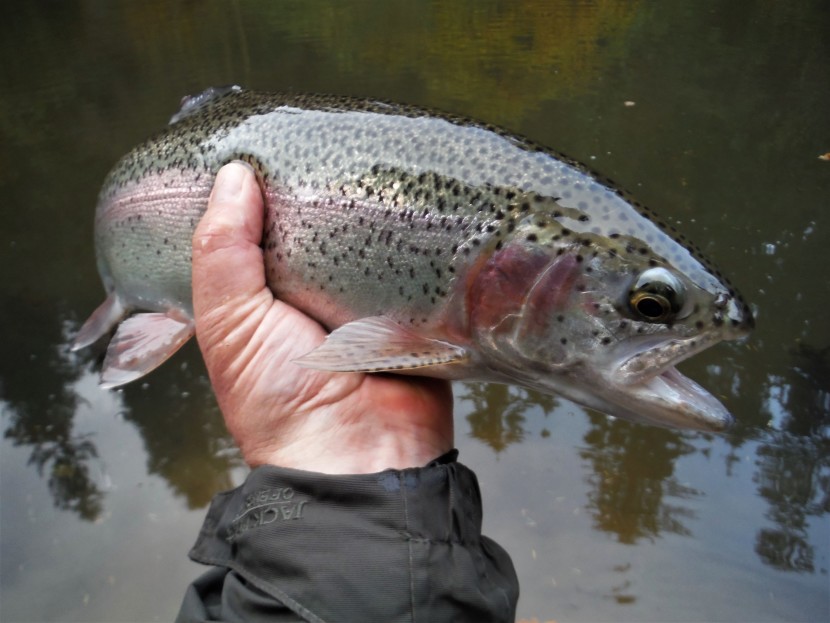 Forest rainbow
Forest rainbow 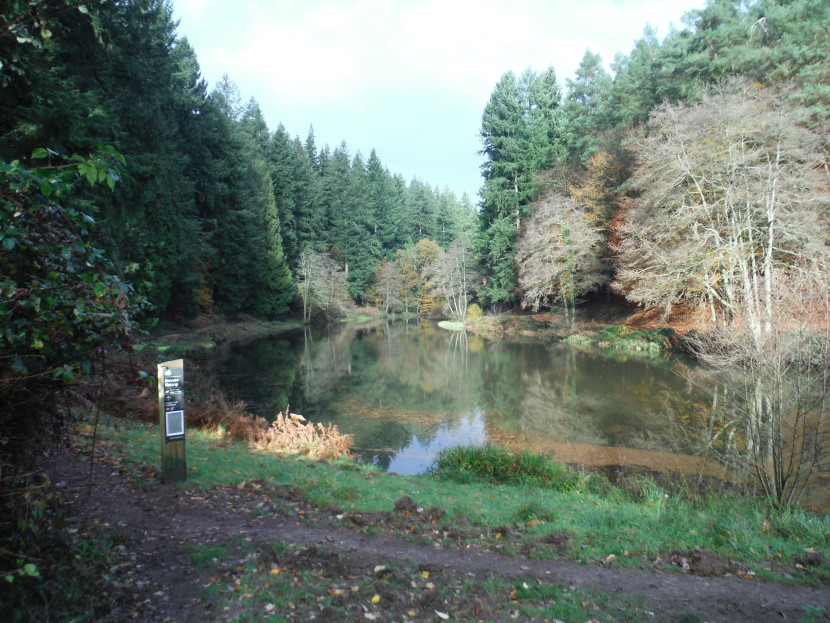 Forest pool
Forest pool That seemed credible. Believe it or not, most small country towns have the odd millionaire or near millionaire living somewhere around. In our case there have been the Bledisloes of the Park Estate where the old Roman temple was found, originally the owners of the tin plate works which employed most of the town, supporters of Lloyd George and the Liberal Party, and donors of the town’s lovely park and open air swimming pool. Then the family whose fortune originated in the purchase and shipping to the UK of war surplus trucks left on Salonika docks in 1919 are still here, as are the commercial tyre wholesaler kings, the steel bridge builders and the rubber manufacturers. With all this money you would expect my home town to look like Stuttgart, but I’m afraid it doesn’t. On reflection, I suppose that with property price inflation as it is, sterling millionaires or near millionaires are hardly worth remarking on these days…but what would I know?
One family you might not immediately associate with the Forest are the Crawshays of South Wales, perhaps better known as the iron masters of Cyfarthfa and also famous for their estate in the Usk valley. However, by the mid-nineteenth century one branch of the family saw an opportunity in the coal and iron industry of the Forest of Dean, the modest and shallow coal pits of the time being worked by the native holders of free-mining rights. Significant investment was need to sink deep mines and the Crawshays were among the first to provide this, paying royalties to the original rights holders. The Crawshays’ commitment to investing in Forest of Dean coal and steel continued well into the twentieth century and for many years the family lived on the Severn estuary side of the Forest, at Oaklands Park near the Gloucester road. For their furnaces and mines, they bought up much land just outside the Royal Forest. And like their cousins in Wales, the Baileys at Glanusk Park and the Crawshays of Dan y Parc, it seems the Crawshays of Oaklands liked to fish.
The story which local historians generally now accept, is that it was this local branch of the Crawshay family who somewhere around the 1880s had the lakes constructed by building four dams in the valley leading down from Littledean, and this purely for the fishing pleasure of the family and friends. Certainly the Crawshays had plenty of interests in the neighbouring valley leading up to Ruspidge and Cinderford, including ironworks, lime kilns and several collieries. In 1899 the Ponds and surrounding woods were sold by Robert Crawshay to the Crown Estate, so that the Forestry Commission now controls the area along with the rest of the Dean. During the 1920s a local man named Morgan used to rent the Ponds for fishing and the one which our own syndicate has rented for more than 70 years is still sometimes known as Morgan’s Pool.
One unconfirmed local story I have always liked is that during the great lock-out of 1926 which lasted 7 months, miners of the area who in conscience could not go underground while the industrial action lasted, nevertheless were given the chance to earn some money by a sympathetic lease holder and agreed to carry out some maintenance and repair work on the dams of the fishing lakes. Families were reportedly in a desperate condition during the lock-out and several striking miners died in the “Wet Woods” digging into a tip for low quality coal which might be sold around. While the pumps were off, the Blackpool Brook flooded for a final time into the galleries of the struggling Howbeach Colliery, which never reopened. I’m old enough to remember listening in the pubs to the bitterness of old men talking about 1926. Might the wage benefactor then have been Morgan or even a Crawshay retaining an interest in the ponds?
The 20th century fishing syndicate which followed has had its ups and downs through a long tenancy with the Forestry Commission. Originally we rented all four ponds until it became difficult to bailiff them efficiently. The lower pool is easily overseen from the road, but the other three are hidden away in the trees. A twice daily patrol turned out to be a minimum necessity, but the employment of a part-time bailiff implied a need for a large membership. Now only the lower lake is retained for fishing, while the others have become overgrown. I can remember that once the pool was stocked with brown trout and fished with split cane rods; today we have rainbows from 2-4 pounds along with a few native browns which manage to spawn in the intake stream, while the members are all armed with carbon wands. Once the lake was drained regularly to kill off weed and remove coarse fish; today it is a SSSI and we manage it with a more relaxed regime. Still the fly-fishing tradition continues. All the other lakes in the Royal Forest are used for coarse fishing although there are commercial trout fisheries nearby and of course the WUF’s Wild Stream scheme has opened up some of the brooks for fly-fishing.
On the subject of the Crawshays, in an old book the other day I came across a clue to a name which had intrigued me for a while. Alfred Crawshay was the originator according to Moc Morgan of a wet fly for the middle Usk named Crawshay’s Olive. Given the Crawshay family’s role in the development and ownership of the South Wales steel industry along with Forest of Dean coal, I liked to think of this lure as the “Millionaire’s Fly.” But which Crawshay was it? Inconveniently, many of the family seemed to have been named Alfred. There was a Captain Crawshay killed in an early flying accident, but more than one of them used the modest military rank of Captain. Tiggy Legge-Bourke thought he might have been some kind of distant cousin to her Bailey ancestors, but the internet didn’t help much. Then I found the following in The Angler’s Weekend Book (Who’s Who of Anglers and Fly Dressers), by Eric Taverner and John Moore:
“CRAWSHAY, ALFRED – Son of Captain Alfred Crawshay of the 17th Lancers, Dan y Parc, Crickhowell. An extraordinarily fine salmon and trout angler and game shot, particularly for snipe. He took from Usk on a single day (18th September 1876) twenty-six salmon – Buckland water. A good natural historian and most accomplished dresser of trout-flies. Until he left in 1895 for Scotland he was a member of the Usk Board of Conservators. Died, 1919 (aged 60-65).”
That certainly sounds like our man. His fly is a great imitation when the large dark olives of spring are around and I still use it sometimes in high water on the Usk.
 Morgan's Pool
Morgan's Pool .jpg?w=830) Crawshays Olive
Crawshays Olive As everybody knows, our straight-talking Home Secretary lost her job this month. Suella Braverman herself might now concede that speaking the truth is dangerous, but speaking it loudly is more so. It’s a rotten job, Home Secretary; you do tend to be blamed for everything. I’m surprised anybody wants it and in any case I find I can’t work up much enthusiasm now for following the latest game of musical chairs indulged in by a dying government. Instead, amid all the letters and arguments about marches and counter-marches and who actually does control the Metropolitan Police, as if this would have any effect on the truly lethal situation playing out in the Middle East, I was thinking back to the month before.
During a trip to Washington in September, Suella Braverman as UK Home Secretary made a speech deliberately targeting an international audience. The subject was the problem faced by the West, both America and Europe, around migration, refugees, asylum claims and integration. Among other things she claimed that multi-culturalism has failed, possibly with dangerous implications for the internal security and stability of western nations, and also that there is a need to revisit or revise the 1951 Refugees Convention which has been the mainstay of the UN and international approach to migration and asylum for 70 years now. The Convention, she felt, needed to be: “fit for our modern age.” Later she made the same speech to the Conservative Party Conference and got a standing ovation from party members – and yet I wondered even then how many people in British politics would really be prepared to back her all the way? Not enough it seems now.
I think even Ms Braverman’s enemies will concede that it was a courageous speech to make, given the fully anticipated reaction from liberal quarters. Leaving aside all the usual suspects wildly accusing her of an extreme right wing or racist approach to the subject of migration, the response of UNHCR was the one which interested me. UNHCR has modernised itself to some extent in recent years (the press office tends to add in brackets “the Refugees Agency” these days, for the benefit of those who muddle the initialism with UNHCHR, the United Nations High Commissioner for Human Rights). Still the office of the High Commissioner for Refugees remains a venerable institution, and one certainly aware of its own distinguished history and gravitas. Recent history confirms that the post of High Commissioner for Refugees very often turns out to be a stepping stone to the top job, UN Secretary General. For that reason alone, I don’t imagine that our Home Secretary really expected UNHCR to roll over and agree that what is in effect the organisation’s founding document is out of date and due for revision…and nor did they. Filippo Grandi’s staff in Geneva came up with a typically UN statement couched in the most diplomatic language, batting off suggestions that the wording of the 1951 Convention should be revised, but claiming instead that what is really needed is that it should enforced more energetically and rigorously. They also assured the UK that UNHCR is ready to help in every way with asylum claimants, including processing. Which was a nice way to remind that in the UK the processing of asylum claims is desperately slow. Over to you Home Secretary Braverman!
The matter won’t stop there and I think Ms Braverman did well to make her speech, despite the fact that I don’t agree with all her points. At the same time and despite justified concerns about open borders and illegal migration into Europe, we should perhaps recognise the scale of the problems which international agencies such as UNHCR have been faced with in the past and no doubt will be in the future. UNHCR currently has more than 20 million refugees as its case load. Back in the day, my own small field office (5 staff including the tea lady) had responsibility for more than 100,000, mostly internally displaced, Bosnian citizens. At the time I joined the agency some quarter of a century ago, the oldest cases on its books were several elderly Armenian ladies living in Alexandria, survivors of the Turkish genocide of 1915.
The modern UN organisation for refugees was founded in 1950, but its antecedents and its institutional memory and experience go back to the first attempts to harness international co-operation on behalf of displaced people. These were made by the League of Nations following the Great War. In that time of chaos, it was felt that not just an ordinary diplomat, but only an international hero, a genius even, would be able to adequately address the humanitarian problems faced by the Nations. Step forward the Norwegian Fridtjof Nansen, famous polar explorer, polymath, inventor and Nobel Prize winner, who was appointed League of Nations High Commissioner for Refugees in 1921.
 Fridtjof Nansen
Fridtjof Nansen Nansen had extraordinary energy and charisma, but just consider the problems he had to face during his tenure. First there was the aftermath of the Armenian genocide, and the work of establishing the survivors around Yerevan in a new Armenian state to the east of Mount Ararat, a state which as it happened was quickly to be absorbed into the Soviet empire. (Even today as I write, 100,000 Armenians are in the process of being ethnically cleansed from Nagorno-Karabakh, although the world has hardly noticed). Then came the dreadful famine of South Russia from 1921-2, caused by crop failure, the revolution and subsequent civil war. This affected the Volga region from Kazan down to the Caspian Sea. Certainly more than a million and according to some sources as many as 5 million people died of starvation and cases of the cannibalism of children were not uncommon. There was a general international response to the disaster, but it was the Americans and President Hoover’s ARA organisation which did most of the heavy lifting, including reprogramming Soviet railway schedules to improve the logistics of food distribution. I can imagine the difficulty of negotiating these arrangements with the new Soviet authorities. Following the war between Greece and Turkey from 1919 to 1923, it was Nansen and his staff who organised the agreed exchange of Christian and Muslim populations between the two nations. As a result 1.5 million people were forcibly resettled, leaving behind them property and centuries of tradition. Greeks had lived in Asia Minor and the Caucasus since before the time of Christ. This legalised “ethnic cleansing” was the internationally agreed solution then to a painful history of violence, but descendants of those involved in both countries now tend to describe it as a disaster. I wonder if anybody considered then whether “multi-culturalism” had been a success or not. At times, I believe it was. Life in the Ottoman Empire wasn’t all wars and massacres.
Nansen died in 1930, but the Nansen International Office for Refugees continued and an international refugee agency survived in some form all through the Second World War. Stateless persons could apply for something called a “Nansen Passport.” The modern UNHCR was founded in 1950, supposedly for only 3 years, but it is still with us today. In recent decades it has necessarily focussed more on Africa and Asia rather than Europe. I do not need to rehearse the long list of conflicts resulting in refugees which occurred through the 20th century. Only displacements from Israel/Palestine are not a UNHCR responsibility, but are looked after by the United Nations Relief and Works Agency. The key words in the 1951 Convention, the phrases which concern Suella Braverman, and which are in fact the critical ones to confirm a person as entitled to asylum are “…someone who is unwilling or unable to return to their country of origin owing to a well-founded fear of being persecuted for reasons of race, religion, nationality, membership of a particular social group, or political opinion.” Another very important part of the same document deals with the principle of “non-refoulement,” in other words meaning that no refugee should be expelled against their will to a country or place where they risk persecution or death. (Refoulement by the way is a French word, so pronounce it that way. It means “push back.”)
“A well-founded fear of being persecuted…” The phrase is clear enough, but surely the interpretation of what it means has changed over the years. I was a field officer rather than a protection officer, but it seems to me that through time the bar has been lowered when these words are being considered. I don’t believe that in my period with the agency, an argument such as “I’m gay, so I’m at risk,” on its own would have resulted in acceptance during an asylum application interview. While working in the Balkans, I can’t recall hearing that particular argument. I can recall several cases where the essential plea was resolved down to: “… I have fallen out with mafia business partners, so my life is at risk if I stay here. Can I go to Germany?” not that we were able to offer any particular encouragement at that time. Imagine a woman in Afghanistan or a whole number of other patriarchal countries arguing: “I’m a woman therefore I’m at risk of persecution here. Put me down on the list for the USA.”
Apart from the famous wording of the 1951 Convention, a whole raft of subsequent negotiations, agreements and papers established wide agreement on further general principles, most of which should be applauded. These were that nations should not deliberately make their citizens stateless. That states bordering countries affected by armed conflict should open their borders to asylum seekers. That asylum should be claimed in the first safe country reached. That other nations in a spirit of burden sharing should rally round with funding and material assistance to support those bordering states hosting large numbers of refugees. An assumption certainly existed that in cases of armed conflict, the asylum seekers would probably be women and children rather than young men in their twenties who would be under military obligation. Another assumption still much discussed is that a “durable solution” is needed for refugees, and that where possible the preferred solution would be “return” home rather than “resettlement” in another country. That return should be achieved “in a phased and orderly manner, in dignity and safety,” a phrase which occupied us a lot in post-war Bosnia. The safety bit took a lot of organising. Essentially it was a question of whether the neighbours who had attacked and expelled them before, would attack the returnees again? A miscalculation in those days had serious consequences. And what about internally displaced persons, who have not crossed an international border? To what extent should the same protections apply to them?
Do we have the right criteria for judging asylum applications? Can we offer asylum in a different country to all women from patriarchal societies or to everybody who is gay? It seems that over time we have come to take a different and softer approach. 30 years ago, such expressions of vulnerability alone would not have been enough to confirm an asylum application. Today it seems that a young man from somewhere who has paid a people smuggler thousands of dollars to cross the Channel into the UK from France in a rubber boat and thrown his documents away can claim: “I’m from Iran and I am gay. My life is at risk if I go back. Give me asylum in the UK,” and he might well get a second hearing. Personally, in that case I would be almost certain I was talking to an economic migrant, not a refugee. The reality of the modern situation might be encapsulated by an Afghan joke which I have mentioned before: “These are difficult times. Every family needs a son fighting with the Northern Alliance. And another son fighting with the Taliban. Because you don’t know who is going to win, do you? And you need a third son in Germany, working and sending money to keep the rest of the family afloat.” It isn’t entirely a joke.
Let’s look again at this word refoulement, which many of our politicians and journalists seem to be encountering for the first time. 25 years ago in a post-war and newly partitioned Bosnia, we were living in a world where hostile crowds quickly turned into dangerous mobs, a world of drive-by shootings, rocket grenades fired in the night, newly laid booby traps and mines under access roads. Some very brave displaced persons were determined to return to situations where they risked violence or at least being persecuted as an ethnic minority, but they had nevertheless made up their minds to reclaim and rebuild their properties. The most courageous were the elderly, particularly old ladies, who were set on getting their homes back whatever the risks. In those early days, before NATO undertook to guard return movements, achieving safe minority return to each burned out village was like renegotiating the Dayton Agreement all over again.
At the same time, Western Europe had granted temporary asylum to over a million displaced Bosnians. Germany in particular was hosting over 350,000. Many of them, particularly younger people, having found work in what seemed to them to be a much more successful economy, were understandably reluctant to return. German public pressure was therefore growing for a faster return of asylum seekers. These, depending on their circumstances, were liable to receive a dreaded document known as a Duldung which put a time limit on their stay. (In Bosnia at this time, several coffee shops opened under the title Café Duldung, presumably to be populated by despondent returnees from Germany!) Men of military age who returned even to situations in Bosnia where they formed the ethnic majority, were likely to receive an unwelcome summons to the local municipality. Essentially the message conveyed would be this: “You evaded military service, failed to pick up a rifle to defend your people. If you know what’s good for you, you will now make amends by paying so many hundred marks for every month you were away working in Germany.” So called “war taxes” were illegal and the international community did what we all could to prevent them, but such demands from the mafia were commonly made and complied with. Meanwhile centre right German politicians became particularly anxious to speed up the return of displaced people to their homes in Bosnia whatever the circumstances, and some seemed to have formed the view that international organisations such as UNHCR working in the field were dragging their heels or being unnecessarily cautious in the matter.
All of which might explain how one day I came to have a very public disagreement with a certain Christian Democrat politician, a German Federal Minister of State no less, a man who considered himself well-placed with both Berlin and Brussels, appointed as an international mediator in Bosnia, and with a particular fondness for driving around the country in a motor convoy escorted by police with flashing blue lights. Of course it’s good at times for internationals working in the field to get some political or military weight behind their initiatives, and for such help from ambassadors or generals we were generally very grateful. On this occasion we were meeting with local authorities in Republika Srpska, Bosnian Muslims who wished to return to several burned out villages as was their right under the Agreement, and their Serb former neighbours, some of whom were hard-line nationalists. Our German visitor, having failed to listen to my briefing, had minutes taken on a lap top which indicated at the end that we had agreement on return to a particular place. I queried that, waited for the translation and asked the Serbs to confirm that they had agreed. They protested that they hadn’t agreed. If looks could kill! The row was quite nasty before the meeting broke up.
Back at the office, I considered the position and particularly my own. I had been forced to tell the Bosniaks that there was no possibility (at that time) for international guarding of their return. They accepted that we didn’t have a deal and that there was a very high chance the return would be attacked, and so they would have to wait while UNHCR kept trying. However, such a public rift with a high level German Government figure risked bringing the agency into disrepute. Rather depressed, I then sent a teletype radio message briefly explaining what had happened and offering my resignation. After which, with a friend from Danish Battalion, a major in G5 who had problems of his own, I went off to a restaurant. I can’t remember what we ate, but we each drank a bottle of red wine before we felt slightly better. Somewhat to my surprise, the next day UNHCR declined to accept my resignation and, when the inevitable complaint arrived, broadly supported my position. However, I don’t think I will ever be forgiven in Germany! A couple of months later we did get a deal involving a one for one reconstruction arrangement for Muslim and Serb houses. That resulted in a successful return to the village in question and indeed to many others in that destroyed municipality, this time supported by the neighbours. The returnees are living there to this day.
The point I am trying to make with this rather convoluted story, is that in the case described the responsible UNHCR office had a better sense of the safety or otherwise of the local situation for returnees than a touring German politician who needed a convoy of police cars for security wherever he travelled. And in the case of Rwanda, for example, I would expect the local UNHCR operation to have a better handle on whether the country is safe for migrants than courts full of human rights lawyers in London or Strasbourg. UNHCR considers Rwanda to be safe and supports asylum seekers there.
Back to discussion of this word refoulement and its application to the enforced return of asylum seekers, refugees and internally displaced persons. In the period I have just described, the risks to our returning beneficiaries involved the likelihood of physical attack or murder. That was enough to solve at one time. Try as we might, there was only so much which we could do practically to combat such problems as preferential treatment given in employment opportunities to the majority ethnic group. I would not have been able to ensure the methods of local police when questioning suspected criminals, the total absence of corruption in local officials, the absence of mafia structures or the level of fairness in state elections. In all these fields and more the international community made efforts, but only with limited success. This is after all how most of the world is. Still, we managed to make these territories “safe” by most objective standards
Today the standards for what can now be considered a “safe” country or territory suitable for either the temporary asylum, return or resettlement of migrants have changed drastically. These days we are always in the hands of the human rights movement. Lawyers and activists on behalf of asylum seekers seem to be demanding overall human rights standards equivalent to those of, for example, Sweden. I am not sure that the standards of many other nations in the world would meet the criteria of perfection being demanded in our courts today. Is this really practical? What are we really expecting?
All these phrases and their interpretation are clearly causing a difficulty to our Home Office and immigration officials, so there should be at least a discussion with UNHCR. Personally I don’t believe that the European Court of Human Rights has anything valuable to contribute to this discussion any more than I believe the Archbishop of Canterbury has. I’m also convinced that the UK and other European countries are experiencing a level of immigration, both legal and illegal, which is going to be very hard to sustain. In fact looking at the condition of our nation and our threatened environment, I think that in a perfect world we should be planning to slowly reduce our population, impossible as this idea might seem at this moment. This is about numbers as much as about cultural differences. To summarise, I think a correct and practical application of the 1951 Convention principles should be enough to protect genuine refugees while allowing the UK to make its own decisions and set its own limits about economic immigration. We can issue visas or not, as it suits us.
Has multi-culturalism failed as Suella Braverman stated in her speech? The mixed reaction in this country to the latest bout of violence in Israel Palestine has certainly caused us to think hard about her contention. It is sadly true that in Britain today you can point out ghetto communities in which there has been no integration, where some women do not even speak English, point to cases of discrimination or the odd race riot and consider that maybe multi-culturalism has failed us. There are people who have come to our country, but who seem to consider their first loyalty still remains with their religion or their originating land, not to the nation they have joined and whose benefits they enjoy. Other nations receiving immigration have similar experiences. But I don’t believe that these examples are the norm, and I think in most cases multi-culturalism has served us well. What I do think we are learning along with most other European countries is that multi-culturalism works when it includes a respect for the host nation culture, a desire to integrate and leave behind old prejudices, and when immigration does not proceed at too fast a rate to allow for adaptation. We do need to have control. Suella did well to open the international discussion on migration and hopefully now somebody else will keep trying!
Oliver Burch
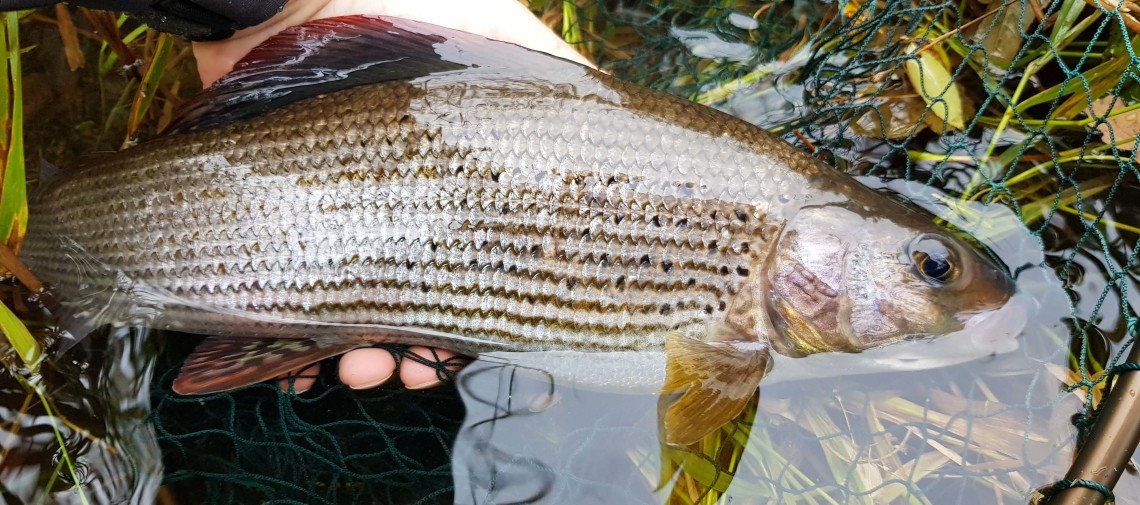 Irfon grayling
Irfon grayling